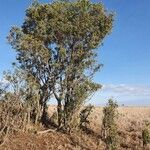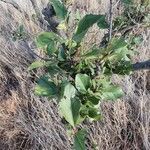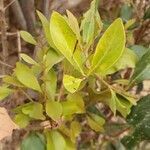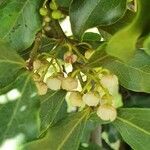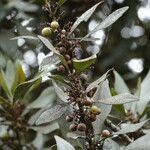Evergreen shrub or small tree 1.8-9(-15) m. tall; bark grey-brown, red-brown, pale mauve-grey or cinnamon or much darker and almost black, mostly rough with shallow irregular longitudinal fissures, flaking longitudinally; slash pink to crimson or pale yellow to orange; sapwood ochraceous or cream, turning apricot on exposure to air; young shoots with rusty peltate scales but otherwise glabrous.. Leaves drying grey-green to chestnut, opposite or subopposite, mostly diamond-shaped (‘ subrhombic’ ) or narrowly rhombic-lanceolate, widest near the middle, 1.6-12 cm. long, 0.6-4.5 cm. wide, narrowed to a ± rounded or emarginate apex, attenuate to narrowly or fairly broadly rounded at the base, the margin often crinkly, glabrous save for rusty peltate scales beneath; venation sometimes slightly raised above but ± inconspicuous; petiole 4-6 mm. long.. Inflorescences paired in at least some axils, unbranched, dense and contracted, up to 1.5 cm. long.. Male flowers ± 3.5 mm. long; calyx yellow, patelliform with short broadly triangular teeth, glabrous save for rusty scales; corolla creamy white, pale yellowish or salmon buff, the lobes sometimes with a pale brown spot, deeply lobed, widely open at the throat, each lobe with more than 25 striga-like hairs along the midpetaline line; stamens ± 16, strigulose; rudimentary ovary with 2 simple or bilobed styles.. Female flowers without staminodes; ovary yellow, densely strigulose.. Fruit brown to black, globose, 5-7 mm. diameter, with short white hairs.. Fig. 8/1-5.
A shrub or small tree up to 8 m in height. Bark: grey-brown, smooth, sometimes roughened with lenticels, becoming dark and cracking into square segments with age; young shoots with rusty brown granules (glands). Leaves: opposite to sub-opposite, rarely spirally arranged on long shoots, elliptic, 3.5-8 x 1-2.5 cm, 3-4 times as long as wide, leathery, stiff, hairless, dark green to greyish green above, frequently finely wrinkled, much paler green below, veins translucent when held against a strong light; apex tapering to rounded; base tapering; margin entire, characteristically very wavy; petiole 4-6 mm long. Flowers: very small, white to creamy yellow, in short dense branched heads, frequently almost round, up to 15 cm in diameter, 2-3 heads per leaf axil; flower stalks dotted with rusty brown scales and 2 oblong curved, deciduous bracts at the base; ovary densely hairy (Jul.-Jan.). Fruit: round, thinly fleshy, about 5-7 mm in diameter, red to purplish black (Oct.-Dec., but sometimes as late as May).
A shrub or small tree. It grows up to 6 m tall. It can be 18 m tall. It often branches from the base. The bark is grey. It is smooth when young and cracked when old. The crown of the tree has many branches and is leafy. The leaves are leathery and with a wavy surface. They are simple leaves and usually almost opposite each other. The upper surface is grey green and the lower surface is paler. Leaves are 3.5-9 cm long and 1-2.5 cm wide. They are oval or sword shaped and taper towards each end. The tip is round. The edges of the leaves is usually very wavy. The flowers are small, cream and cup shaped. They are produced in short dense heads in the axils of leaves. Male and female flowers occur on separate plants. The flowers and stalks are covered with tiny rusty-brown dots. The fruit is small round berries on stalks. They have a thin flesh and usually one seed. They are edible.
Leaves usually opposite or subopposite; petiole 0·4–0·6 cm. long; lamina up to 9 x 4 cm., variable in width, otherwise uniform, subrhombic or subtrullate, broadest at or below the middle, apex acute, the tip itself rounded, base attenuate and slightly concave, margin often strongly undulate; lower surface glabrous except for rusty, peltate scales; lateral nerves and main veins sometimes slightly raised above, otherwise inconspicuous.
Shrub, 2-6 m high. Young leaves and twigs glabrous. Leaves narrowly elliptic, elliptic or occasionally lanceolate, margin strongly undulate. Inflorescences dense and contracted, solitary or 2 or 76 mm each axil. Corolla cleft halfway down. Flowers white to cream.
Corolla deeply lobed, widely open at the throat, each lobe with more than 25 strigulose hairs along the mid–petaline line.
Inflorescence paired in at least some leaf–axils, unbranched, dense and contracted, up to 1·5 cm. long.
Calyx patelliform with short, broadly deltate teeth, glabrous except for rusty, peltate scales.
Evergreen shrub or small tree up to 9 m. tall (elsewhere up to 15 m.).
Bark grey–brown to black, usually rough and longitudinally fissured.
Young shoots glabrous except for rusty, peltate scales.
Pistillode with 2 simple or bilobed stylodes.
Female flowers without staminodes.
Male flowers c. 0·35 cm. long.
Fruit c. 0·7 cm. diameter.
Stamens c. 16, strigulose.
Ovary densely strigulose.
